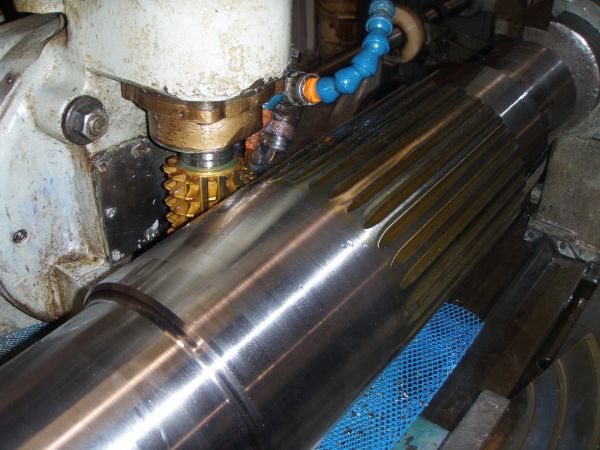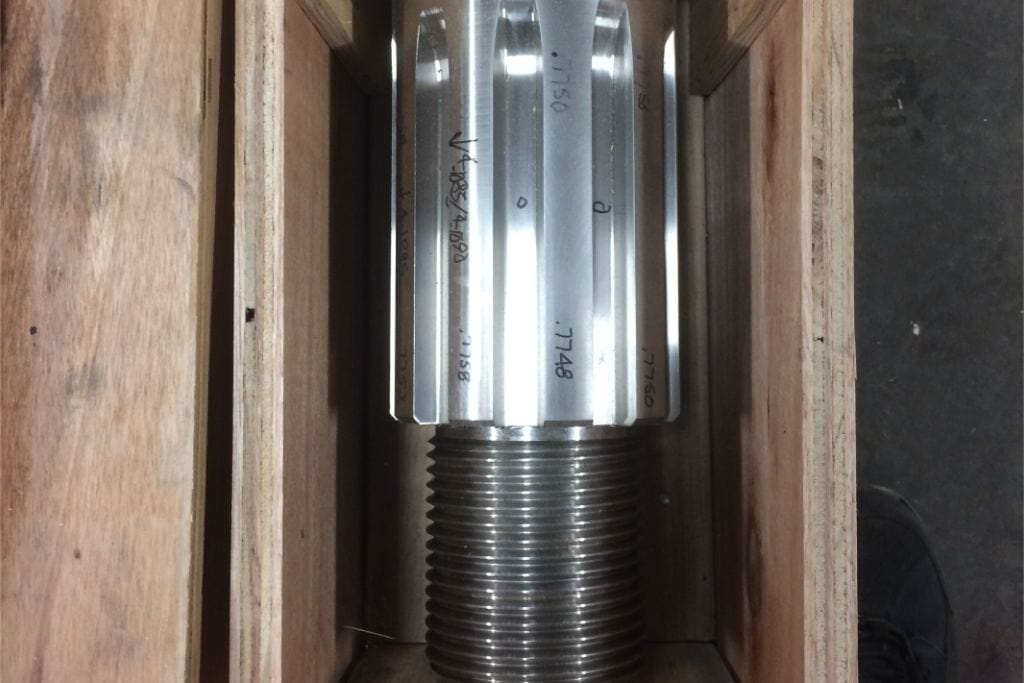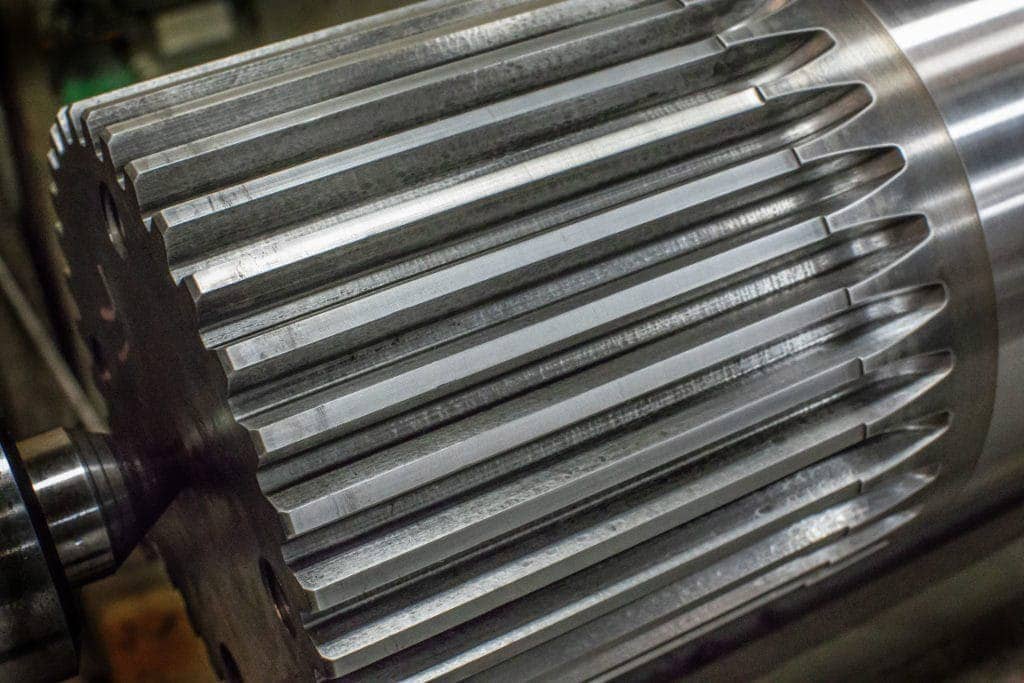Due to the high amount of pressure present in most transmission applications, spline shaft materials must be extremely strong and durable. With extended use, splined shafts can warp and crack. It is therefore important to ensure that you have the right spline shaft material for your particular application. Splined shafts are typically manufactured using sturdy metals, including:
 A splined shaft is characterized by the deep grooves, or splines, cut along the entire length of the outer material. The grooves create jutting keys that fit into paired bearings, bores, gears, or bushings specifically designed to mate with the shaft splines. When compared with more traditional drive shafts, the added grooves provide resistance to rotation in anti-rotation applications. They are also used to transmit torque in both linear and rotary drive applications. In this blog, we discuss the operation, material, manufacture, and uses of splined shafts.
A splined shaft is characterized by the deep grooves, or splines, cut along the entire length of the outer material. The grooves create jutting keys that fit into paired bearings, bores, gears, or bushings specifically designed to mate with the shaft splines. When compared with more traditional drive shafts, the added grooves provide resistance to rotation in anti-rotation applications. They are also used to transmit torque in both linear and rotary drive applications. In this blog, we discuss the operation, material, manufacture, and uses of splined shafts.
How Do Splined Shafts Work?
Spline shafts are designed to maximize the amount of contact between the shaft surface and interlocking parts. When used for anti-rotary applications, a spline shaft locks into place, preventing rotation while still allowing for linear motion. When acting as a linear guard, the interlocked bearing or gear will often slide up or down the shaft to ensure accurate linear movement without allowing unwanted rotation.
When used in rotary applications, splined shafts rotate while interlocked with a gear, bearing, or other mechanism. The high level of contact between mated surfaces helps to transmit high levels of force, or torque, between mechanisms. There are a variety of splined shaft designs specifically tailored to the needs of particular power transmission applications.
Splined Shaft Applications
Splined shafts are critical to a broad range of applications, from manufacturing and industrial facilities to public transportation, automobiles, and aerospace equipment. Splined shafts are capable of transmitting torque for high speed applications and heavy-duty load bearing equipment. They are often found in automobile drive trains, where they transform rotary motion into linear motion.
Splined shafts are built to withstand high-speed rotation, with exceptional control and uniform load distribution across the entire spline groove. More evenly distributed force allows for more reliable load transmission and higher speeds without the risk for catastrophic part misalignments.
Types of Splined Shafts
Splined shafts are available in a wide assortment of designs, depending on the shape, space, and size of the grooves and keys on the shaft and mated components. The most common types of splined shafts include:
Types of Splined Shafts
Splined shafts are available in a wide assortment of designs, depending on the shape, space, and size of the grooves and keys on the shaft and mated components. The most common types of splined shafts include:
-
Parallel key
Parallel key splined shaft designs feature square-shaped keys and grooves with profiles that run parallel to the shaft’s axis. This design is ideal for load-bearing applications that require smooth motion.
-
Involute splines
This type of splined shaft decreases stress on the shaft by using tapered keys and ridges. Involute splines are typically used in high speed and high stress applications for better torque and reduced potential for slippage or misalignment.
What Materials are Splined Shafts Made From?
- Alloy steels. Alloy steels are iron-based—or ferrous—alloys that contain a blend of other metals used to enhance certain characteristics such as ductility, hardness, toughness, and tensile strength. Alloy steels may include chromium, nickel, molybdenum, and copper in addition to iron.
- Aluminum alloys. An excellent lightweight option for many applications, aluminum alloys are less dense than steel, but with a high strength-to-weight ratio. They are tougher than some steels, and can perform well under high pressures. In addition, aluminum alloys are corrosion-resistant and will not rust when exposed to moisture.
- Carbon steel. Carbon steel features iron with up to 1.7% carbon content. This material produces very strong components with an exceptional degree of accuracy.
- Stainless steels. Stainless steels are distinguished by their corrosion resistance. This alloy contains chromium, which interacts with air to create a protective oxidized layer that prevents rust and corrosion. In addition, stainless steels are strong, durable, and wear-resistant with high tensile strength.
How are Splined Shafts Manufactured?
Splined shafts are typically cut using specialized machining processes to create highly accurate teeth and grooves. In spline machining, precision is critical to ensuring that the shaft fits snugly against other components for optimal power transmission. At Jerpbak-Bayless, we are pleased to offer three primary methods of spline shaft manufacturing:
- CNC Turning: CNC turning uses lathes and cutting tools directed by computer numeric control (CNC) software. Rotating the tools and workpiece on up to 5 axes, the shaft can be machined with exceptional precision, even for extremely complex components. Multi-axis operation allows for fine cuts at virtually any angle with speed unmatched by other more traditional methods.
- CNC Milling: Similar to CNC Turning, CNC milling uses a lathe to hold the workpiece as rotating mill cutters precisely remove extra material to create the desired groove and tooth shapes. Our 5-axis CNC milling equipment allows us to create splines, gears, bearings, and other precision components within extremely tight tolerances.
- Specialty Machining: Jerpbak-Bayless' extensive machining capabilities include customized specialty machining for unusual or specialized components. Using state-of-the-art CNC machining, we can shape splines both inside and out, enabling us to produce quality spline profiles in virtually any size and shape.
Quality Splined Shafts from Jerpbak-Bayless
At Jerpbak-Bayless, we are committed to producing quality splined shafts and components for a variety of industries and applications. No matter how complex your component, we have the equipment and skill to produce splined shafts that meet and exceed even the most rigorous specifications and industry standards.
Contact us today to learn more about our splined shaft machining services, or request a quote for your next project.



